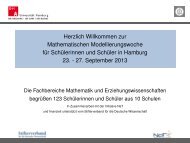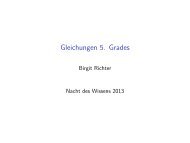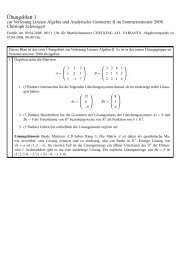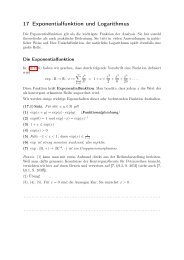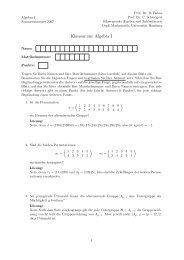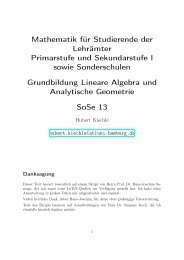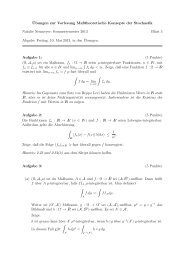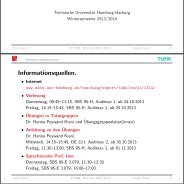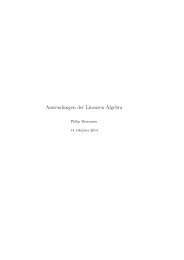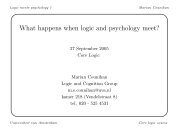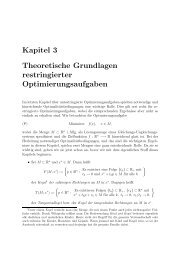pdf file
pdf file
pdf file
Create successful ePaper yourself
Turn your PDF publications into a flip-book with our unique Google optimized e-Paper software.
Lemma 2.3.5.<br />
Let (A, μ, η, Δ, ɛ) be a finite-dimensional (weak) bialgebra and A ∗ = Hom K (A, K) its linear<br />
dual. Then the dual maps<br />
Δ ∗ : (A ⊗ A) ∗ ∼ = A ∗ ⊗ A ∗ → A ∗<br />
ɛ ∗ : K → A ∗<br />
μ ∗ : A ∗ → (A ⊗ A) ∗ = A ∗ ⊗ A ∗<br />
η ∗ : A ∗ → K<br />
define the structure of a (weak) bialgebra (A ∗ , Δ ∗ , ɛ ∗ , μ ∗ , η ∗ ).<br />
Remark 2.3.6.<br />
For any (weak) bialgebra (A, μ, η, Δ, ɛ), we have three more (weak) bialgebras:<br />
A opp = (A, μ opp , η, Δ, ɛ) A opp,copp = (A, μ opp , η, Δ copp , ɛ)<br />
A copp = (A, μ, η, Δ copp , ɛ)<br />
2.4 Tensor categories<br />
We wish to understand more structure that is present on the categories of modules over bialgebras.<br />
In particular, from our experience with Lie algebras and group algebras, we expect<br />
that the tensor product V ⊗ W of two modules V and W over a bialgebra A carries again the<br />
structure of an A-module. This turns a pair of objects (V, W ) of the category A−mod into an<br />
object V ⊗ W , and a pair of morphisms (f, g) into a morphism f ⊗ g.<br />
Definition 2.4.1<br />
The Cartesian product of two categories C, D is defined as the category C × D whose objects<br />
are pairs (V, W ) ∈ Obj(C) × Obj(D) and whose morphisms are given by the Cartesian product<br />
of sets:<br />
Hom C×D ((V, W ), (V ′ , W ′ )) = Hom C (V, V ′ ) × Hom D (W, W ′ ) .<br />
We are now ready to discuss the structure induced by the tensor product of modules:<br />
Definition 2.4.2<br />
1. Let C be a category and ⊗ : C × C → C a functor, called a tensor product.<br />
Note that this associates to any pair (V, W ) of objects an object V ⊗W and to any pair of<br />
morphisms (f, g) a morphism f ⊗ g with source and target given by the tensor products<br />
of the source and target objects. In particular, id V ⊗W = id V ⊗ id W and for composable<br />
morphisms<br />
(f ′ ⊗ g ′ ) ◦ (f ⊗ g) = (f ′ ◦ f) ⊗ (g ′ ◦ g) .<br />
2. A monoidal category or tensor category consists of a category (C, ⊗) with tensor product,<br />
an object I ∈ C, called the tensor unit, and natural isomorphisms, called the associator,<br />
of functors C × C × C → C and<br />
such that the following axioms hold:<br />
a : ⊗(⊗ × id) → ⊗(id × ⊗) .<br />
r : id ⊗ I → id and l : I ⊗ id → id<br />
25




